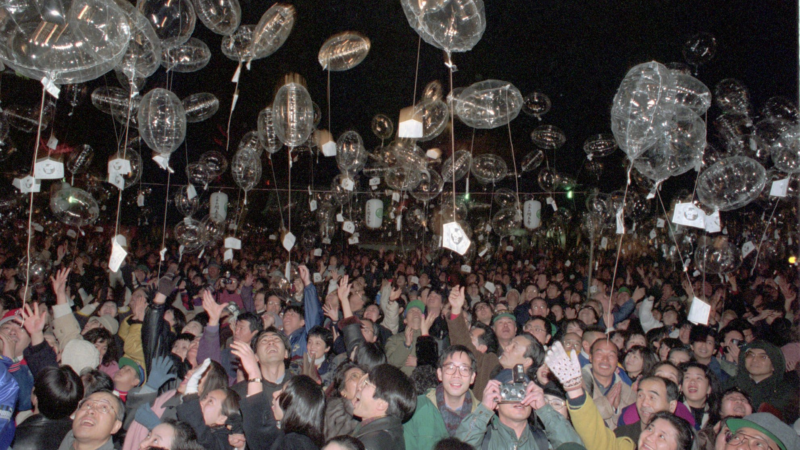Backyard feeders changed the shape of hummingbird beaks, scientists say
A new study suggests that Anna’s Hummingbirds in the western United States are not only keeping up with human influence on their habitat, they’re thriving.
According to a recent study in Global Change Biology, a journal focused on environmental change, the use and prevalence of hummingbird feeders — like those red and clear plastic ones filled with homemade sugar water — changed the size and shape of the birds’ beaks. The range of the hummingbird also spread from the southern part of California all the way up the West coast into Canada.
“Very simplified, the bills get longer and they become more slender, and that helps to have a larger tongue inside that can get more nectar from the feeder at a time,” says Alejandro Rico-Guevara, a professor of biology at the University of Washington and senior author on the study.
The study, which had been in the works since 2019 and had 16 collaborators across 12 different institutions, also found that the beaks of males grew pointier over time to allow them to fight off competing males at the feeders. The hummingbirds also moved further north, eventually showing up in much cooler temperatures as they chased the growing popularity of the bird feeders. The study also noted the influence of the growing abundance of eucalyptus forests, another human-influenced food source for the hummingbirds as the trees were introduced to California from Australia in the 1900s.
Hummingbird history
During the research process, the study authors sifted through newspaper archives in California, tracking hummingbird feeder mentions by county and comparing that to census data and scientific bird counts.
They also studied museum specimens of Anna’s Hummingbirds dating back to the 1800s — well before the popular outdoor bird feeders existed — providing a range of beaks to measure over about 10 generations of the species.
Simon English, a Ph.D. candidate at the University of British Columbia and one of the co-authors of the study, helped comb through all the data to figure out how it all fit together.
“The contribution of the feeders was remarkable,” he says. “As far as a single contribution to an effect that humans have, it was very strong, very surprising.”
Bird metrics

Faye Romero, now a Ph.D. candidate at the University of Rochester and also a co-author on the study, says she spent many of her undergraduate years at the University of California, Berkeley measuring those old hummingbird museum specimens, helping to gather the data to show the physical change of the birds.
“It’s a really interesting example of how our actions as humans are actively changing the organisms around us,” she says, noting that in this case, the birds are keeping up. “But because they’re keeping up now doesn’t mean they will forever, or all the other organisms will keep up, too.”
Humanity’s influence
Richard Prum is an evolutionary ornithologist at Yale University, who was not involved in the study, but has read it.
“Human behavior and human environments have greatly affected the evolution of birds, and in lots of ways,” he says.
He points to the domestication of wild junglefowl to create what we now call a chicken, for example. Or the common pigeon, also called the rock dove, which originally nested on cliff faces in remote areas.
“But of course, that choice of nesting on a rock face is a lot like a building, yeah? So we build buildings, and it turns out we have just provided a huge amount of habitat for nesting rock doves or pigeons,” Prum says.
He said he thinks Anna’s Hummingbird expansion north could be “just the beginning of the story,” and it’s unclear what effect that could have, good or bad.
“That’s a huge question,” he says.
Rico-Guevara, the senior author of the study, says for him one of the biggest takeaways was just how quickly evolution — something generally assumed to happen over millions of years — can take place.
“It’s a demonstration of how evolution happens, like, literally in front of our eyes. And we just need to pay attention to it,” he says.
His brother’s mental illness isolated his family. Now he’s helping other caregivers
When it comes to serious mental illness, family caregivers are crucial partners. But often, they must fend for themselves. A new solution offers them support.
Out with the mayo: How Ukrainians reclaim holiday food
For many people from former Soviet countries, New Year's is a big holiday feast time. A Ukrainian restaurant in Washington gives NPR a taste of what's on the menu.
Farmers are about to pay a lot more for health insurance
Tariffs, inflation, and other federal policies have battered U.S. farmers' bottom lines. Now many farmers say the expiration of federal health care subsidies will make their coverage unaffordable.
50 wonderful things from 2025
Each year, critic Linda Holmes looks back on the year and compiles a list of the things that brought her joy.
Why do we make New Year’s resolutions? A brief history of a long tradition
One of the earliest mentions of New Year's resolutions appeared in a Boston newspaper in 1813. But the practice itself can be traced back to the Babylonians.
In one year, Trump pivots fentanyl response from public health to drug war
Experts say Biden's focus on addiction health care saved tens of thousands of lives and slowed fentanyl smuggling. Trump scrapped Biden's approach in favor of military strikes.







